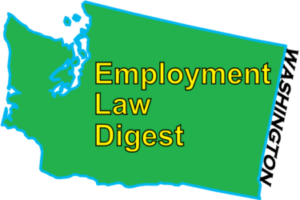This is a case summary of Dailey v. North Coast Life Insurance Company, 129 Wn.2d 572 (Wash. 1996). Subjects include, but are not limited to the following:
» WASHINGTON LAW AGAINST DISCRIMINATION (“LAD” or “WLAD”)
» PUNITIVE (EXEMPLARY) DAMAGES
IMPORTANT: This article is for informational purposes only and is based upon my point of view. This is not a resource for the actual and complete appellate court opinion. Due to the rapidly changing nature of the law, we make no warranty or guarantee concerning the accuracy or reliability of the content in this article. No content on this site, regardless of date, should ever be used as a substitute for direct legal advice from your attorney. Please review our Disclaimer|Terms of Use|Privacy Policy before proceeding.

case summary – 7 Facts:
[1] On March 16, 1990, Defendant North Coast Life Insurance Co. terminated Plaintiff Julie Dailey’s employment.
[2] Dailey and co-Plaintiff Gregory Dailey filed a wrongful termination claim that included an allegation of sex discrimination in violation of the LAD and specifically sought punitive damages.
[3] Both parties moved for partial summary judgment on the availability of punitive damages under the LAD.
[4] The trial court granted Plaintiffs’ motion, concluding RCW 49.60.030(2) both permitted punitive damages in an employment discrimination action and operated retrospectively.
[5] Defendants appealed.
[6] At the request of the Court of Appeals, the Supreme Court accepted certification of the case.
[7] We now reverse.
Dailey v. North Coast Life Insurance Company, 129 Wn.2d 572 (Wash. 1996) (hyperlinks added). This case summary includes both the Majority and Concurring Opinions.
» MAJORITY OPINION: DOLLIVER, Justice; DURHAM, C.J., and SMITH, GUY and MADSEN, JJ., concur.
ISSUE #1 (Majority Opinion): Did the trial court err in granting Plaintiff’s motion, concluding RCW 49.60.030(2) both permitted punitive damages in an employment discrimination action and operated retrospectively?

[1-1] WA STATE SUPREME COURT HAS CONSISTENTLY DISAPPROVED PUNITIVE DAMAGES AS CONTRARY TO PUBLIC POLICY: “Since its earliest decisions, this court has consistently disapproved punitive damages as contrary to public policy.” Dailey v. North Coast Life Insurance Company, 129 Wn.2d at 574 (citing Spokane Truck & Dray Co. v. Hoefer, 2 Wash. 45, 50-56, 25 P. 1072 (1891)).
[1-2] PUNITIVE DAMAGES IMPOSE ON DEFENDANT A PENALTY RESERVED FOR CRIMINAL SANCTIONS AND AWARD PLAINTIFF WITH WINDFALL BEYOND FULL COMPENSATION: “Punitive damages not only impose on the defendant a penalty generally reserved for criminal sanctions, but also award the plaintiff with a windfall beyond full compensation.” Id. (citing Kadoranian v. Bellingham Police Dep’t, 119 Wash.2d 178, 188, 829 P.2d 1061 (1992)).
[1-3] THE WA STATE LEGISLATURE HAS ASSURED THAT PLAINTIFFS MAY BECOME WHOLE THROUGH COMPENSATORY DAMAGES: “Particularly in the case of workplace discrimination, the Legislature has assured a plaintiff may ‘become whole’ through a full panoply of compensatory damages.” Id. (citing Barr v. Interbay Citizens Bank, 96 Wash.2d 692, 699-700, 635 P.2d 441, amended by 96 Wash.2d 692, 649 P.2d 827 (1982)).
[1-4] PUNITIVE DAMAGES REQUIRE EXPRESS LEGISLATIVE AUTHORIZATION: “Governing resolution of this case is the court’s long-standing rule prohibiting punitive damages without express legislative authorization.” Id. at 575 (internal citations omitted).
[1-5] FEDERAL CIVIL RIGHTS ACT:
Civil Rights Act of 1964 — Provided Private Remedies: “The Civil Rights Act of 1964 provided private remedies for employment discrimination in Title VII, historically authorizing only equitable relief.” Id.
Civil Rights Act of 1991 — Allowed Greater Trial Costs: “By the Civil Rights Act of 1991, Congress amended the 1964 Act to allow greater trial costs, including expert fees.” Dailey v. North Coast Life Insurance Company, 129 Wn.2d at 575-76 (citing 42 U.S.C. § 2000e-5(k); see Xieng v. Peoples Nat’l Bank, 120 Wash.2d 512, 528, 844 P.2d 389 (1993)).
“Revised Statutes” Amendments (42 U.S.C. § 1981a) — Allowed Compensatory and Punitive Damages for Intentional Employment Discrimination: “The 1991 Act also amended 42 U.S.C. § 1981a, known as the Revised Statutes, to permit compensatory and punitive damages in an action for intentional employment discrimination:
provided that the complaining party cannot recover under section 1981 of [the Revised Statutes (42 U.S.C. § 1981) ], the complaining party may recover compensatory and punitive damages as allowed in subsection (b) of this section, in addition to any relief authorized by section 706(g) of the Civil Rights Act of 1964, from the respondent.
Dailey, 129 Wn.2d at 576 (citing 42 U.S.C. § 1981a(a)(1)) (alteration in original) (paragraph formatting and hyperlinks added).
[1-6] WASHINGTON LAW AGAINST DISCRIMINATION (WLAD):
1973 — Private Equitable and Compensatory Relief Allowed Under the WLAD: “Since 1973, the Legislature has authorized private equitable and compensatory relief under the LAD:
to enjoin further violations, to recover the actual damages sustained by him, or both, together with the cost of suit including a reasonable attorney’s fees or any other remedy authorized by this chapter or the United States Civil Rights Act of 1964….
Dailey, 129 Wn.2d at 575 (citing former RCW 49.60.030(2)).
1993 — Legislature Amended the WLAD to Acknowledge the Civil Rights Act of 1991: “In 1993, the Legislature acknowledged the Civil Rights Act of 1991 by amending RCW 49.60.030(2) to ‘any other remedy authorized by this chapter or the United States Civil Rights Act of 1964 as amended.'” Dailey, 129 Wn.2d at 575 (citing RCW 49.60.030(2)) (hyperlink and emphasis added).
[1-7] UNDER CIVIL RIGHTS ACT OF 1991 PUNITIVE DAMAGES OPERATE PROSPECTIVELY ONLY: “The United States Supreme Court has determined punitive damages under the Civil Rights Act of 1991 operate prospectively only.” Dailey, 129 Wn.2d at 578 (citing Landgraf v. USI Film Prods., 511 U.S. 244, —-, 114 S.Ct. 1483, 1496, 128 L.Ed.2d 229 (1994)).
[1-8] PROVISION OF PUNITIVE DAMAGES, A PENALTY AND A NEW RIGHT OF ACTION DO NOT QUALIFY AS REMEDIAL AMENDMENT TO PERMIT PRSUMPTION OF RETROACTIVITY: “[T]he provision of punitive damages, a penalty and a new right of action [do not] qualify as a remedial amendment to permit a presumption of retroactivity.” Id. at 578 (citing Agency Budget Corp. v. Washington Ins. Guar. Ass’n, 93 Wash.2d 416, 425-26, 610 P.2d 361 (1980); Johnston v. Beneficial Management Corp., 85 Wash.2d 637, 640-41, 538 P.2d 510 (1975); see Landgraf, 511 U.S. at —-, 114 S.Ct. at 1506-07).

[1-9] THE STATUTORY AUTHORITY IS TOO AMBIGUOUS AND ATTENUATED TO BE EXPRESS: In this case, “[t]he trial court determined the LAD, RCW 49.60.30(2), expressly authorized punitive damages by incorporating that federal remedy by reference to the United States Civil Rights Act of 1991, 42 U.S.C. § 1981a(a)(1).” Dailey, 129 Wn.2d at 575 (citing Mackay v. Acorn Custom Cabinetry, Inc., 127 Wash.2d 302, 316, 898 P.2d 284 (1995) (Madsen, J., dissenting) (“noting RCW 49.60.030(2) does not authorize punitive damages under state law”)) (emphasis and hyperlinks added).
∴ Majority Court’s Analysis: “While we do not fault the trial court’s analytic framework, we find the statutory authority too ambiguous and attenuated to suffice as express.” Id.
[1-10] AMBIGUITIES PRECLUDE EXPRESS AUTHORIZATION FOR PUNITIVE DAMAGES: “Ambiguities cloud the relation between 42 U.S.C. § 1981a(a)(1) and RCW 49.60.030(2) to preclude characterization of their link as an express authorization for punitive damages.” Dailey, 129 Wn.2d at 576 (hyperlinks added).
∴ Majority Court’s Analysis — Amendment Limited to Costs:
“First, the structure of the language in RCW 49.60.030(2) arguably evinces an intent to incorporate only federal remedies qualifying as ‘costs.’ While the trial court read the provision as: ‘to recover the actual damages … together with … any other remedy …,’ we might reasonably read the term ‘including’ as restrictive: ‘the cost of suit including … any other remedy….’ Under the latter interpretation, punitive damages simply would fall outside the scope of the incorporation provision.” Dailey, 129 Wn.2d at 576 (hyperlink added).
“We need not choose between these alternative meanings … to decide the resultant ambiguity cannot overcome Washington’s policy against punitive damages.” Id.
∴ Majority Court’s Analysis — Implied Incorporation Is Not Express Authorization:
“We find equally disturbing the relation between the provision of punitive damages in the Civil Rights Act of 1991 and the Civil Rights Act of 1964. RCW 49.60.030(2) explicitly incorporates only the 1964 Act as amended, but whether the 1991 Act actually constitutes an amendment to the 1964 Act is unclear.” Dailey, 129 Wn.2d at 576 (hyperlink added).
“The Civil Rights Act of 1991 did not directly amend Title VII to permit punitive damages, but rather amended the Revised Statutes, 42 U.S.C. § 1981a. Indeed, the amendment explicitly describes compensatory and punitive damages ‘in addition to’ remedies available under the 1964 Act.” Dailey, 129 Wn.2d at 576-77 (citing 42 U.S.C. § 1981a(a)(1)) (hyperlinks added).
“An implied incorporation of the 1991 Act does not meet our standard for express authorization.” Id. at 577.
[1-11] THE COURT REAFFIRMS AND DISTINGUISHES XIENG: “The trial court found controlling this court’s prior analysis of the interplay between RCW 49.60.030(2) and the 1991 Act in Xieng, 120 Wash.2d 512, 844 P.2d 389.” Dailey, 129 Wn.2d at 577 (hyperlink added). “Analyzing the scope of the incorporation of federal remedies by reference, Xieng held express legislative authorization for expert witness fees under the LAD lies in the explicit expert witness fee provision of the Civil Rights Act of 1991…. The trial court concluded Xieng compelled incorporation of all federal relief provided in the 1991 Act.” Dailey, 129 Wn.2d at 577 (internal citations omitted).
∴ Majority Court’s Analysis: “We reaffirm and distinguish Xieng[ ][:]
Both the nature of the remedy and the relevant statutory authority in Xieng differ from the present case. Certainly expert witness fees have not received the extreme resistance and condemnation as punitive damages. See Spokane Truck, 2 Wash. at 50-56, 25 P. 1072.
Unlike the punitive damages provision, the expert witness fee provision contains an explicit amendment to the 1964 Civil Rights Act. 42 U.S.C. § 2000e-5(k).
Moreover, the presence of the explicit amendatory language in 42 U.S.C. § 2000e-5(k) reinforces our concern for the lack of an equally explicit amendment to the 1964 Act in 42 U.S.C. § 1981a(a)(1).
At the same time, the incorporation of expert witness fees in Xieng is consistent with an interpretation of RCW 49.60.030(2) as limiting the incorporation of federal remedies to costs of suit. See Xieng, 120 Wash.2d at 528, 844 P.2d 389.
Dailey, 129 Wn.2d at 577 (paragraph formatting added).
[1-12] IF LEGISLATURE INTENDED TO MAKE PUNITIVE DAMAGES AVAILABLE UNDER THE WLAD, IT WOULD HAVE UNAMIBUOUSLY SO PROVIDED: “Where the Legislature has intended the exceptional relief of punitive damages, the statute has contained an explicit authorization.” Id. at 577 (citing RCW 9.73.230(11); RCW 19.86.090). “The Legislature here, presumably aware of Congress’ decision to allow punitive damages in the 1991 Civil Rights Act, had the opportunity to follow suit in its 1993 amendments to the LAD.” Dailey, 129 Wn.2d at 577.
∴ Majority Court’s Analysis: “If the Legislature intended to make punitive damages available for employment discrimination under the LAD, it would have unambiguously so provided.” Id.
[1-13] PLAINTIFF’S CLAIM IS UNTIMELY — RETROSPECTIVE PUNITIVE DAMAGES ARE UNAVAILABLE: The Court “observe[d] that even if the LAD permitted punitive damages for employment discrimination generally, that relief would remain unavailable in the present case.” Id. at 578.
∴ Majority Court’s Analysis: “The Civil Rights Act, the only potential authorization for punitive damages under the LAD, did not permit that relief until 1991. Plaintiffs’ claim concerns conduct prior to 1991.” Id. “Retrospective punitive damages thus could not constitute a ‘remedy available’ under the Civil Rights Act.” Id. (citing RCW 49.60.030(2); McGinnis v. Kentucky Fried Chicken, 51 F.3d 805, 807-08 (9th Cir.1994)).

[1-14] PUNITIVE DAMAGES ARE UNAVAILABLE UNDER THE WLAD, RCW 49.60; RETROSPECTIVE PUNITIVE DAMAGES ARE UNAVAILABLE UNDER THE FEDERAL CIVIL RIGHTS ACT: In this case, the Court held that “punitive damages are unavailable under the Law Against Discrimination (LAD), RCW 49.60.” Dailey, 129 Wn.2d at 574 (hyperlink added). Moreover, “[r]etrospective punitive damages … could not constitute a ‘remedy available’ under the Civil Rights Act.” Id. at 578.
» CONCURRING OPINION: TALMADGE, Justice (concurring); JOHNSON, ALEXANDER and SANDERS, JJ., concur.
“Although I agree with the majority that the trial court erred in granting summary judgment for Ms. Dailey in this case, I disagree with the majority’s analysis on exemplary damages under RCW 49.60.030(2), and therefore write separately.” Dailey v. North Coast Life Insurance Company, 129 Wn.2d at 578 (emphasis added). NOTE: The term “exemplary damages” is synonymous with punitive damages. See Black’s Law Dictionary 417 (8th ed. 2004).
ISSUE #2 (Concurring Opinion): Did “the Legislature intend[ ] by its 1993 amendments to RCW 49.60, our Law Against Discrimination, to incorporate the remedy of exemplary damages allowed in federal civil rights actions[ ]”?

[2-1] FEDERAL LAW
Before 1991 — Punitive Damages Unavailable to Federal Civil Rights Plaintiffs: “Prior to 1991, a successful federal civil rights plaintiff generally could not recover exemplary damages.” Dailey, 129 Wn.2d at 578-79 (citing 42 U.S.C. § 2000e-5).
After 1991 — Punitive Damages Available to Successful Litigants Under the Civil Rights Act of 1964: “In the 1991 Civil Rights Act, Congress included a new statutory section, 42 U.S.C. § 1981a, which provides:
In an action brought by a complaining party under section 706 or 717 of the Civil Rights Act of 1964 [42 U.S.C. §§ 2000e-5, 2000e-16] against a respondent who engaged in unlawful intentional discrimination (not an employment practice that is unlawful because of its disparate impact) prohibited under section 703, 704, or 717 of the Act [42 U.S.C. §§ 2000e-2, 2000e-3], and provided that the complaining party cannot recover under section 1981 of this title, the complaining party may recover compensatory and punitive damages as allowed in subsection (b) of this section, in addition to any relief authorized by section 706(g) of the Civil Rights Act of 1964, from the respondent.
Dailey, 129 Wn.2d at 579 (emphasis and hyperlinks added). Thus, “[u]nder the terms of the statute, a successful litigant under the Civil Rights Act of 1964 can recover exemplary damages.” Dailey, 129 Wn.2d at 579.
[2-2] WASHINGTON LAW
1993 Amendments: “In 1993, the Washington Legislature adopted amendments to RCW 49.60.030(2) relating to private actions under RCW 49.60, allowing a party to seek:
to enjoin further violations, or to recover the actual damages sustained by the person, or both, together with the cost of suit including reasonable attorneys’ fees or any other appropriate remedy authorized by this chapter or the United States Civil Rights Act of 1964 as amended, …
Dailey, 129 Wn.2d at 580 (citing Laws of 1993, ch. 69, § 1; Laws of 1993, ch. 510, § 3(2)) (emphasis in original) (hyperlinks added). “The ‘as amended’ language was adopted in two separate legislative enactments by the 1993 Legislature, ch. 69, Laws of 1993, § 1 and ch. 510, Laws of 1993, § 3(2).” Dailey, 129 Wn.2d at 580.
1995 Reenactment: “The Legislature reenacted RCW 49.60.030(2) in its present form combining the disparate amendments to RCW 49.60.030 in Ch. 135, Laws of 1995, § 3.” Dailey, 129 Wn.2d at 580. “Thus, on three separate occasions in 1993 and 1995, the Legislature adopted legislative language incorporating into RCW 49.60 remedies authorized by the 1991 amendment to the Civil Rights Act of 1964.” Dailey, 129 Wn.2d at 580 (hyperlinks added).
The Legislature Intended to Incorporate Federal Remedies in the WLAD: “By adopting the ‘as amended’ language in 1993 and 1995, the Legislature intended to incorporate federal remedies in RCW 49.60.” Dailey, 129 Wn.2d at 581 (hyperlink added).
Rule of Statutory Construction (Presumed Awareness): “The Legislature is presumed to be aware of judicial interpretation of its statutes.” Id. at 581 (citing Friends of Snoqualmie Valley v. King County Boundary Review Bd., 118 Wash.2d 488, 496, 825 P.2d 300 (1992)).
Rule of Statutory Construction (Presumption of Acquiescence): “Another principle of statutory construction [is that] “Legislative silence regarding the construed portion of the statute in a subsequent amendment creates a presumption of acquiescence in that construction.” Id. (citing Baker v. Leonard, 120 Wash.2d 538, 545, 843 P.2d 1050 (1993)) (internal citations omitted).
[2-3] RETROACTIVE APPLICATION OF THE 1993 AMENDMENTS: “In Landgraf v. U.S.I. Film Prods., a former employee brought an action alleging sexual harassment and retaliation in violation of Title VII of the Civil Rights Act of 1964[ ][:]
The United States Supreme Court held the provisions of the 1991 Civil Rights Act, including 42 U.S.C. § 1981a, do not apply to a case pending on appeal when the statute was enacted, and had prospective effect only. The Court declined to apply the 1991 amendments retroactively unless Congress made clear such an intent. The Court found no such clear Congressional intent for retroactive application of the 1991 amendments.
Dailey, 129 Wn.2d at 582 (citing Landgraf v. U.S.I. Film Prods., 511 U.S. 244, 114 S.Ct. 1483, 1505, 128 L.Ed.2d 229 (1994)) (hyperlinks added).

[2-4] FEDERAL LAW — SUCCESSFUL CLAIMANTS MAY RECOVER PUNITIVE DAMAGES UNDER THE 1964 CIVIL RIGHTS ACT AS AMENDED BY 1991 LEGISLATION:
“The majority determines the 1991 Civil Rights Act may not have amended the 1964 Civil Rights Act, majority op. at 5, based on an argument first raised by amicus Washington Defense Trial Lawyers Association that 42 U.S.C. § 1981a is a separate section and does not actually amend the text of the Civil Rights Act of 1964.” Dailey, 129 Wn.2d at 579 (hyperlink added).
∴ Concurring Court’s Analysis: “This hypertechnical argument ignores the plain language of 42 U.S.C. § 1981a(a)(1) allowing exemplary damages in ‘an action brought by a complaining party under § 706 or 717 of the Civil Rights Act of 1964 …'” Dailey, 129 Wn.2d at 579 (hyperlink added).
Example: McGinnis v. Kentucky Fired Chicken: “In McGinnis v. Kentucky Fried Chicken, 42 F.3d 1273 (9th Cir.), amended and superseded by 51 F.3d 805 (9th Cir.1994), the United States Court of Appeals for the Ninth Circuit specifically held punitive damages are allowed under the Civil Rights Act of 1964 as amended by the 1991 Civil Rights Act: ‘Punitive damages are authorized by that statute today.'” Dailey, 129 Wn.2d at 579-80 (internal citations omitted).
Example: Landgraf v. U.S.I. Film Prods.: “The United States Supreme Court in Landgraf v. U.S.I. Film Prods., 511 U.S. 244, 114 S.Ct. 1483, 128 L.Ed.2d 229 (1994) similarly held exemplary punitive damages were available under the Civil Rights Act of 1964.” Dailey, 129 Wn.2d at 580.
“As interpreted by the federal courts, successful federal civil rights claimants may recover exemplary damages under the 1964 Civil Rights Act, as amended by the 1991 legislation, as a means of enforcing federal antidiscrimination law.” Dailey, 129 Wn.2d at 580.
[2-5] WASHINGTON LAW — EXPRESS AUTHORIZATION DOES NOT REQUIRE THE SPECIFIC WORDS “PUNITIVE DAMAGES”
“Notwithstanding … the statutory language, the majority finds exemplary damages are unavailable to claimants under RCW 49.60.030 because of Washington’s strong public policy against punitive damages.” Dailey, 129 Wn.2d at 580 (internal citations omitted) (hyperlink added). “The majority asserts exemplary damages are unavailable under Washington law in the absence of express statutory authorization. By this, the majority seems to mean the Legislature must use the specific words “punitive damages.” Id. at 580-81.
∴ Concurring Court’s Analysis:
“This argument is too literal and ignores the clear direction of RCW 49.60.030 and the legislative history of the state and federal enactments.” Id. at 581 (hyperlink added).
The McGinnis Case. “By 1995, when the Legislature again amended RCW 49.60.030(2), the Legislature had the benefit of the decisions in Landgraf and McGinnis[ ][:]
In McGinnis, the Ninth Circuit held exemplary damages are available to successful claimants under RCW 49.60 because RCW 49.60.030(2) incorporated federal remedies and the Civil Rights Act of 1964, as amended in 1991, permitted successful claimants to recover exemplary damages.
Dailey, 129 Wn.2d at 581 (hyperlinks added).
Canons of Statutory Construction. “[T]he Legislature [was not] ignorant of the nature of its own actions. As we have stated: The Legislature is presumed to be aware of judicial interpretation of its statutes.” Id. “Another principle of statutory construction [is that] ‘Legislative silence regarding the construed portion of the statute in a subsequent amendment creates a presumption of acquiescence in that construction.'” Id. “The Legislature had to know it was incorporating the federal remedy of punitive damages into RCW 49.60.” Dailey, 129 Wn.2d at 581 (hyperlink added).
Legislature’s Intent Rendered Meaningless. “By adopting the ‘as amended’ language in 1993 and 1995, the Legislature intended to incorporate federal remedies in RCW 49.60. But the majority’s interpretation of RCW 49.60.030(2) renders virtually meaningless the Legislature’s intent[:]
RCW 49.60.030(2) specifically mentions injunctive relief, and recovery of actual damages, costs and a reasonable attorney fee. We have already allowed expert witness fees as a cost of litigation. Xieng v. Peoples Nat’l Bank, 120 Wash.2d 512, 528, 844 P.2d 389 (1993)).
The reference to federal law remedies must be intended to expand upon the already mentioned remedies. However, beyond injunctive relief, compensatory damages, costs and attorney fees, nothing of substance is left but the punitive damages added to federal law in 1991.
Dailey, 129 Wn.2d at 581-82 (hyperlinks added). “The Legislature clearly understood it was adopting exemplary damages as part of Washington’s antidiscrimination law when it amended RCW 49.60.030(2) in 1993 and 1995.” Dailey, 129 Wn.2d at 582 (hyperlink added).
[2-6] RETROACTIVE APPLICATION OF THE 1993 AMENDMENTS: “Counsel for Ms. Dailey argues the amendments to RCW 49.60.030(2) must be applied retroactively because they are remedial in nature.” Dailey, 129 Wn.2d at 582.
∴ Concurring Court’s Analysis: “I disagree. Because the Legislature adopted a federal remedy, we are obliged to construe the federal remedy in accordance with Congressional intent as understood by the federal courts.” Id. at 582 (citing Xieng, 120 Wash.2d at 528-29, 844 P.2d 389).
“The United States Supreme Court in Landgraf determined the 1991 amendments to the Civil Rights Act of 1964 providing for compensatory and punitive damages could not be retroactively applied. If Ms. Dailey may not recover exemplary damages under federal law, she may not recover exemplary damages under RCW 49.60.030(2), as amended.” Dailey, 129 Wn.2d at 582-83.

[2-7] FEDERAL CIVIL RIGHTS CLAIMANTS MAY RECOVER PUNITIVE DAMAGES UNDER CIVIL RIGHTS ACT OF 1964, AS AMENDED; WA LEGISLATURE CLEARLY UNDERSTOOD IT WAS ADOPTING PUNITIVE DAMAGES WHEN IT AMENDED RCW 49.60.030(2); AND PLAINTIFF CANNOT RETROACTIVELY APPLY PUNITIVE DAMAGES:
The concurring Court evaluated this case based on three categories and concluded as follows:
1. Regarding Federal Law:
As interpreted by the federal courts, successful federal civil rights claimants may recover exemplary damages under the 1964 Civil Rights Act, as amended by the 1991 legislation, as a means of enforcing federal antidiscrimination law.
Dailey, 129 Wn.2d at 580.
2. Regarding WA Law:
The Legislature clearly understood it was adopting exemplary damages as part of Washington’s antidiscrimination law when it amended RCW 49.60.030(2) in 1993 and 1995.
Dailey, 129 Wn.2d at 582
3. Regarding Retroactive Application of 1993 Amendments:
The United States Supreme Court in Landgraf determined the 1991 amendments to the Civil Rights Act of 1964 providing for compensatory and punitive damages could not be retroactively applied. If Ms. Dailey may not recover exemplary damages under federal law, she may not recover exemplary damages under RCW 49.60.030(2), as amended.
Dailey, 129 Wn.2d at 582-83.
LEARN MORE
If you would like to learn more, consider contacting an experienced employment discrimination attorney to discuss your case. This article is not offered as legal advice and will not establish an attorney-client relationship with Washington Employment Law Digest or the author of this article. By reading this article, you agree to our Disclaimer / Terms-of-Use / Privacy Policy.




